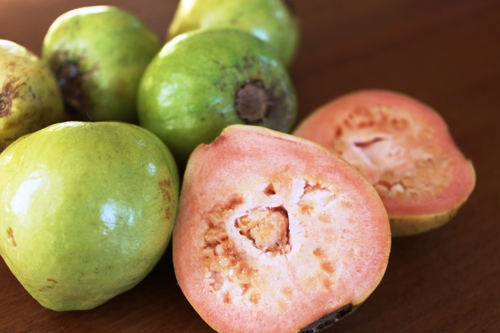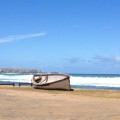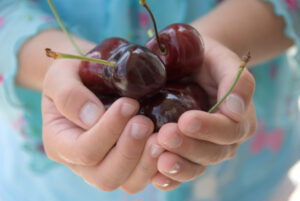
Virgil Evetts
To most New Zealanders, a guava is a small red fruit, used almost exclusively for making jellies and jams. With the exception of a few morbidly obese and pathologically indiscriminate Kereru, nobody really eats them because they’re gritty, sharp and according to many, smell of cat pee. I don’t actually agree with that last bit. I rather like the smell, which may say more about me than it does about the finer points of fruit fragrance but it’s true that over all they’re not very versatile.
It’s a good thing then that there is more to the guava family than this species – the so called strawberry guava (Psidium littorale ). In fact they only barely count as guavas at all. The real or ‘common’ guava (Psidium guajava), so beloved in the tropic and the base for all those deliciously musky guava fruit drinks is a very different beast –or plant as it- were altogether.
The fruit of true or ‘tropical’ guava range can be larger than an apple (but are most often quite a bit smaller), have shiny green, yellow or rose blushed skin and either baby-pink or pearly white flesh. They pack an intensely musky, resinous fragrance and sour-sweet taste, with a granular, pear-like texture.
Although often described as a tropical fruit, the trees grow quite happily in warm temperate climates too. Here in New Zealand they are becoming an increasingly common site at farmers markets and the better fruit shops during the winter months and are gaining in popularity as backyard fruit tree. Probably the only thing holding them back from widespread commercial success is consumer ignorance and confusion with the aforementioned strawberry guava.
In tropical Asia guava are most often peeled, deseeded and dipped in a bracing blend of salt, sugar and chilli. The contrasting flavours and sensations work together on so many levels and it’s one of the only ways guavas are ever eaten fresh. The guava is a very fine fruit- perhaps one of the finest, but it’s hardly a pick it and go affair.
As a dessert fruit they are easily on par with peaches and pears and are similarly well suited to poaching. To poach1 kilo of fresh guavas, make light syrup with 1 cup sugar and 3 cups water. Bring to boil and add the halved fruit. Simmer for no more than 5 minutes. Leave to cool, then remove and discard the gritty seeds. Serve chilled alone or with other poached fruit, with ice cream or made into a crumble using ginger nuts and toasted coconut in the crust.
Alternatively, guavas make an excellent fruit paste for serving with cheese. Use this quince paste recipe with the guavas in place of the quince.
Guavas are not really sweet or juicy enough for conventional juicing but are commonly used to make delectable fruit nectars. Nectars are sweetened and often quite thick fruit drinks, rather like a hybrid of a smoothy and a cordial. They are generally made with a puree of lightly cooked fruit, citric or ascorbic acid and sugar, ensuring long term shelf life if sealed.
The following recipe will produce something very similar to off the shelf guava nectar (but containing far more real fruit) and can successfully and rather deliciously be applied to strawberry guavas, feijoas, apricots and peaches. This nectar is naturally quite thick because the very high pectin levels of guava. This quality also makes guavas idiot proof candidates for jam and jelly making!
Guava Nectar
I kilo guavas -fresh OR canned. (or other fruit see above)
1 cup sugar
3 cups of water
1 teaspoon citric acid
Pinch of salt
Method
Halve and poach guavas as described above, but do not discard seeds or syrup.
Using a spoon, force the fruit through a sieve and back into the syrup. Keeping working at it until all that remains in the sieve are seeds and a little fibre.
Discard the seeds etc and return the syrup and fruit pulp to the boil along with the citric acid, salt and 700mls water. Boil for 2-3 minutes and remove from heat. Over cooking will result in a jammy flavour.
Bottle and store in a cool place. Serve well chilled. Refrigerate once opened.
Just about the most refreshing drink I know and one of the sexiest too!
Tropical guava trees are available from garden centres in the North Island, but these are usually of the same rather average South African kind i.e. small, seedy fruit with low sugar levels. Subtropica and Russell Fransham nurseries offer a good range of superior tropical guava varieties and both happily courier plants nationwide.




Hi there,
My name is Marc, I am hoping to buy a pink guava tree in New Zealand. Would you know who I could contact for this?
Thanks
I’m surprised that you think people don’t eat the little red (or yellow) guavas. Most people I know eat them. One problem is that people don’t know how to pick them. You don’t pull them off the tree, you just gently touch them and if they fall off they’re ripe. Otherwise they can be too tart. My tree is absolutely laden with them and so many have fallen off that my section smells like a winery. I haven’t been able to give them away this year as I’ve been in the fruit fly area. Unfortunately in Northland you can no longer eat them straight off the tree as we now have guava moths that leave the insides all mushy and yuk so you have to cut them before you eat them. I just cut them in half, sprinkle them with sugar, leave for a few hours and eat with greek yoghurt (or cream or ice-cream – yum!). I’m really sad because normally the trees are full of kukupa stuffing themselves until they’re so full they can’t fly and tumble out of the tree. This year for the first time in 50 years, I haven’t had a single one. It’s quite a worry – I’m wondering what has happened to them.
LOVE GUAVAS, even th small berry type,eaten fresh straight off the tree,(I can stand by the tree for hours eating the fruit this way! but I would like to grow the larger type (such as in the imported tinned variety, Where in NZ would I buy such a tree? or, is the answer “forget it”.
Hi -just wanted to comment what I have just read about Guava’s. The first time I came across a fresh Guava (other than those little red ones we have in our back yards) is when I was walking through a market in Egypt – and I could smell them before I could see them! I had only seen the large juicy variety in a tin before this – so wasn’t sure what they even looked like fresh…. but I knew I could smell them. I walked on until I came to a huge pile of large green skinned guava shaped fruit that my sense of smell had led me to. I immediately bought some and tucked straight into them. I wasn’t disappointed with the totally fresh taste that equalled the smelling sensation! I have never seen or been able to buy fresh guava since – so your article was very interesting and knowing that they are available in nz? is very exciting – but I want the same variety as I found in Egypt.
regards
sue